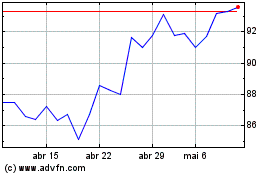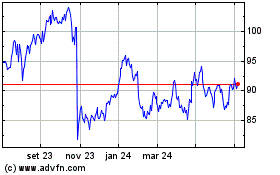Press Release: Phase 2 data published in NEJM show potential of
frexalimab as high-efficacy therapy in relapsing MS
Phase 2 data published in NEJM show potential of
frexalimab as high-efficacy therapy in relapsing MS
- High-dose frexalimab significantly
reduced disease activity, demonstrating 89% reduction in new brain
lesions
- Phase 3 trials in relapsing MS and
non-relapsing secondary progressive MS currently underway
Paris, February 15, 2024. The
New England Journal of Medicine published results from a positive
Phase 2 clinical trial demonstrating frexalimab significantly
slowed disease activity in people with relapsing multiple sclerosis
(MS), corresponding to 89% and 79% reduction in new
gadolinium-enhancing (GdE) T1 brain lesions at Week 12 in the high-
and low-dose treatment arms compared to placebo, meeting the
study’s primary endpoint. Findings also showed both doses of
frexalimab provided significant reduction in new or enlarging T2
lesions, a secondary endpoint of the study. Frexalimab is Sanofi’s
novel second-generation investigational anti-CD40L antibody that
has a unique method of action with the potential to address both
acute and chronic neuroinflammation in MS without causing
lymphocyte depletion. These data were previously presented at
Consortium of Multiple Sclerosis Centers annual meeting 2023.
Patrick Vermersch, MD, PhD
University of Lille, CHU Lille, France“These published Phase 2
results for frexalimab represent important data in not only the
potential treatment of MS but to the broader MS community. Of note,
at Week 12, both doses of frexalimab provided reduction of new
lesions – a standard measure of active inflammation in MS – and was
well-sustained over time and well tolerated, especially at the high
dose of frexalimab where 96% of patients were free of new active
lesions after 24 weeks of treatment.”
Results published in NEJM stem from the Phase 2
clinical trial that randomized 129 adults with relapsing MS to
receive one of two doses of the anti-CD40L antibody frexalimab
(n=52 and n=51, in the high- and low-dose treatment arms,
respectively) or matching placebo (n=12 and n=14, respectively;
pooled for efficacy analyses). In the high-dose treatment arm,
participants received 1200 mg of frexalimab intravenously every 4
weeks with an 1800 mg loading dose. In the low-dose treatment arm,
participants received 300 mg of frexalimab subcutaneously every 2
weeks with a 600 mg loading dose. After 12 weeks of treatment, both
doses of frexalimab led to significant reductions in:
- The number of new GdE T1-lesions at
Week 12, providing rate ratios of 0.11 (95% CI, 0.03 to 0.38) and
0.21 (95% CI, 0.08 to 0.56), corresponding to 89% and 79% reduction
in the high- and low-dose treatment arms versus placebo, the
primary endpoint.
- The number of new/enlarging
T2-lesions at Week 12, providing rate ratios of 0.08 (95% CI, 0.03
to 0.26) and 0.14 (95% CI, 0.05 to 0.41), corresponding to 92% and
86% reduction in the high- and low-dose treatment arms versus
placebo, respectively, a secondary endpoint.
- The total number of GdE T1-lesions
at Week 12 providing rate ratios of 0.12 (95% CI, 0.04 to 0.36) and
0.20 (95% CI, 0.07 to 0.53) corresponding to 88% and 80% reduction,
respectively, another secondary endpoint.
The effects on the primary endpoint were
sustained over time across both treatment arms, with even greater
reduction seen in the high-dose frexalimab treatment arm, as 96% of
these study participants were free of new GdE T1-lesions at Week
24.
Exploratory endpoints looked at changes in the
Multiple Sclerosis Impact Scale 29 (MSIS-29), a patient-reported
outcome, plasma neurofilament light chain (NfL), which has been
identified as a biomarker of neuroaxonal damage and MS disease
activity, as well as plasma levels of CXCL13, a biomarker of
inflammatory activity. Over 12 weeks of treatment, patient-reported
outcome MSIS-29 physical impact scores improved significantly in
participants receiving the higher dose of frexalimab. The
least-square [LS] mean difference (95% confidence interval) was
-7.9 (-14.7,-1.2), compared to pooled placebo. Both doses of
frexalimab achieved a reduction in NfL levels relative to baseline
(24% and 18% in the high- and low-dose treatment arms,
respectively) and in CXCL13 levels relative to baseline (21% and
30% in the high- and low-dose treatment arms, respectively)
compared to pooled placebo at Week 12.
Frexalimab was well-tolerated, and 125 (97%)
participants completed Part A and continued to the open-label Part
B. The most common adverse events (≥5%) in any frexalimab-treated
group were COVID-19 (n=5 [9.8%] in the lower-dose group; all
uncomplicated cases of mild or moderate intensity) and headache
(n=1 [2.0%] and n=3 [5.8%] in the low- and high-dose group,
respectively).
Sanofi has initiated Phase 3 clinical trials of
frexalimab in relapsing MS and non-relapsing secondary progressive
MS.
About the Phase 2 trial The Phase 2 trial was a
randomized, double-blind, placebo-controlled trial evaluating
frexalimab in participants with relapsing MS. Participants were
randomized (4:4:1:1) to receive either high or low doses of
frexalimab or matching placebo for 12 weeks (Part A). The primary
endpoint was the reduction in the number of new GdE T1 MRI brain
lesions at Week 12. Secondary endpoints included additional
MRI-based efficacy measures as well as the safety, tolerability and
pharmacokinetics of frexalimab. After Week 12, participants
receiving placebo switched to respective frexalimab arms and
entered the open-label Part B, which is currently ongoing.
About frexalimab Frexalimab (SAR441344) is a
potentially best-in-disease second generation investigational
anti-CD40L antibody that blocks the costimulatory CD40/CD40L
pathway which is important for activation and function of adaptive
(T and B cells) and innate (macrophages/microglia and dendritic
cells) immunity. Through this unique upstream mechanism of action,
frexalimab has the potential to address both acute and chronic
neuroinflammation in MS, without causing lymphocyte depletion.
Sanofi is developing frexalimab under an exclusive license from
ImmuNext Inc. Frexalimab is being evaluated in Phase 3 clinical
trials for Multiple Sclerosis and Phase 2 clinical trials for
Sjogren’s Syndrome, Systemic Lupus Erythematosus, and Type 1
Diabetes, and its safety and efficacy have not been reviewed by any
regulatory authority. For more information on frexalimab clinical
trials, please visit www.clinicaltrials.gov.
About Sanofi We are an innovative global
healthcare company, driven by one purpose: we chase the miracles of
science to improve people’s lives. Our team, across some 100
countries, is dedicated to transforming the practice of medicine by
working to turn the impossible into the possible. We provide
potentially life-changing treatment options and life-saving vaccine
protection to millions of people globally, while putting
sustainability and social responsibility at the center of our
ambitions.Sanofi is listed on EURONEXT: SAN and NASDAQ: SNY
Media RelationsSandrine
Guendoul | + 33 6 25 09 14 25
| sandrine.guendoul@sanofi.com
victor.rouault@sanofi.comSally Bain | +
1 617 834 6026 | sally.bain@sanofi.comVictor
Rouault | + 33 6 70 93 71 40
| victor.rouault@sanofi.comTimothy Gilbert | + 1
516 521 2929 | timothy.gilbert@sanofi.com
Investor RelationsEva
Schaefer-Jansen | + 33 7 86 80 56 39
| eva.schaefer-jansen@sanofi.comArnaud
Delépine | + 33 6 73 69 36 93 |
arnaud.delepine@sanofi.comCorentine
Driancourt | + 33 6 40 56 92 21 |
corentine.driancourt@sanofi.comFelix
Lauscher | + 1 908 612 7239 |
felix.lauscher@sanofi.comTarik Elgoutni| + 1
617 710 3587 | tarik.elgoutni@sanofi.comNathalie
Pham | + 33 7 85 93 30 17 |
nathalie.pham@sanofi.com
Sanofi Forward-Looking
StatementsThis press release contains forward-looking
statements as defined in the Private Securities Litigation Reform
Act of 1995, as amended. Forward-looking statements are statements
that are not historical facts. These statements include projections
and estimates and their underlying assumptions, statements
regarding plans, objectives, intentions and expectations with
respect to future financial results, events, operations, services,
product development and potential, and statements regarding future
performance. Forward-looking statements are generally identified by
the words “expects”, “anticipates”, “believes”, “intends”,
“estimates”, “plans” and similar expressions. Although Sanofi’s
management believes that the expectations reflected in such
forward-looking statements are reasonable, investors are cautioned
that forward-looking information and statements are subject to
various risks and uncertainties, many of which are difficult to
predict and generally beyond the control of Sanofi, that could
cause actual results and developments to differ materially from
those expressed in, or implied or projected by, the forward-looking
information and statements. These risks and uncertainties include
among other things, the uncertainties inherent in research and
development, future clinical data and analysis, including post
marketing, decisions by regulatory authorities, such as the FDA or
the EMA, regarding whether and when to approve any drug, device or
biological application that may be filed for any such product
candidates as well as their decisions regarding labelling and other
matters that could affect the availability or commercial potential
of such product candidates, the fact that product candidates if
approved may not be commercially successful, the future approval
and commercial success of therapeutic alternatives, Sanofi’s
ability to benefit from external growth opportunities, to complete
related transactions and/or obtain regulatory clearances, risks
associated with intellectual property and any related pending or
future litigation and the ultimate outcome of such litigation,
trends in exchange rates and prevailing interest rates, volatile
economic and market conditions, cost containment initiatives and
subsequent changes thereto, and the impact that pandemics or other
global crises may have on us, our customers, suppliers, vendors,
and other business partners, and the financial condition of any one
of them, as well as on our employees and on the global economy as a
whole. The risks and uncertainties also include the
uncertainties discussed or identified in the public filings with
the SEC and the AMF made by Sanofi, including those listed under
“Risk Factors” and “Cautionary Statement Regarding Forward-Looking
Statements” in Sanofi’s annual report on Form 20-F for the year
ended December 31, 2022. Other than as required by applicable law,
Sanofi does not undertake any obligation to update or revise any
forward-looking information or statements.
Sanofi (BIT:1SAN)
Gráfico Histórico do Ativo
De Mar 2024 até Abr 2024

Sanofi (BIT:1SAN)
Gráfico Histórico do Ativo
De Abr 2023 até Abr 2024
